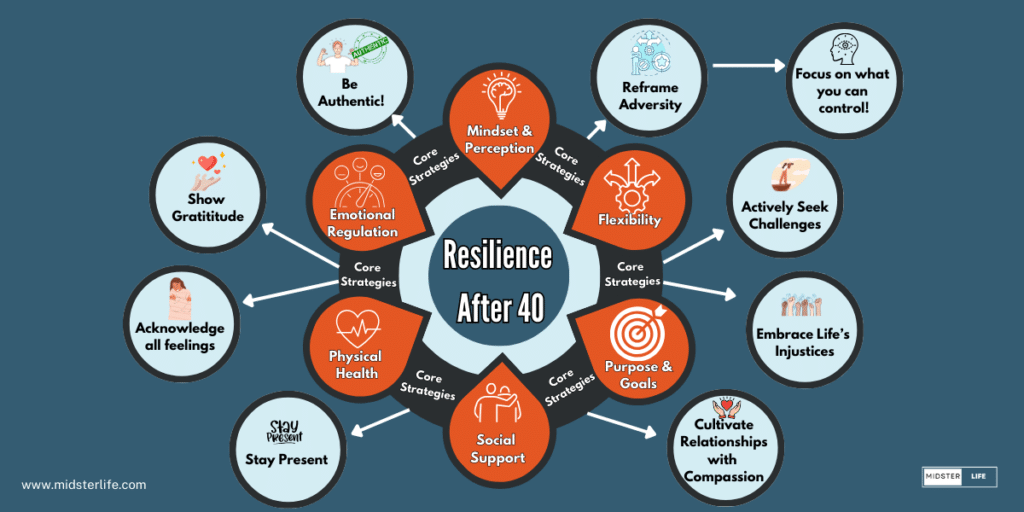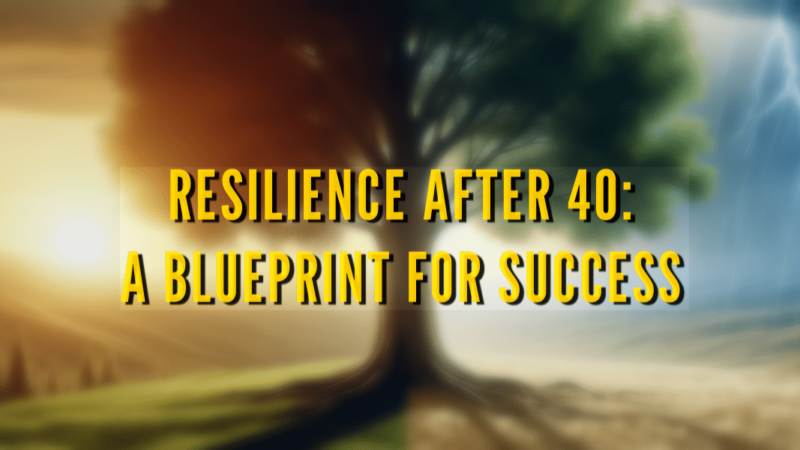Resilience After 40: The Ultimate Blueprint For Success
Growing up in the 80s and 90s, we learned life’s ropes without a GPS, and the only ‘streaming’ we knew involved a cassette tape and a pencil. Now, as we cruise through midlife, the skills we picked up from those simpler times are being tested in new ways. Sure, we might have been the kings and queens of the arcade, but the complex game of midlife sometimes asks for more than quick reflexes.
This post is a nod to those of us who’ve traded our boomboxes for Bluetooth yet occasionally find the soundtrack of adulthood skipping a beat. We’re not always ready for the unexpected plot twists that life throws our way. But here’s the good news: we can learn to dance to this new rhythm with a little thing called resilience – the quiet voice that says ‘keep going’ when the going gets tough. Let’s explore how to crank up that volume and move to the beat of challenges with agility and grace.
Key Takeaways:
- Even for the generation that grew up with scraped knees and freedom, midlife comes with its unique boss battles.
- Resilience after 40 is our secret power-up for bouncing back and adapting to these new quests.
- It’s time to buff our inner stats because, in the game of life, midlife is just the next level, not game over.
What is Resilience?
Resilience is our inner strength that steadies us when life throws us curveballs. It’s the invisible armor that helps us stand firm—whether we’re facing a minor hiccup or a major upheaval.
Key Points:
- Resilience is your comeback power—how you rebound after life’s hiccups.
- Think of it as your mental toolkit, ready to fix up surprises life throws at you.
- Resilience keeps you cool when challenges arise and helps you face them with determination.
Strategies to Boost Your Resilience:
- Adapt to Change: Life can be as unpredictable as the weather in spring. Becoming friends with change means you’re ready, come rain or shine.
- Solve Problems Actively: When puzzles present themselves, put on your thinking cap and play the role of a problem-solver.
- Maintain Positivity: Train your eyes to spot the silver lining, even when clouds are gray.
Resilience isn’t a trait that you’re born with or without. It’s a skill you can develop and refine, like sculpting your own masterpiece. We can grow stronger, wiser, and more resilient with each new day.
The Need for Resilience After 40
Stepping into the 40s can feel like entering a new chapter with its own twists and turns. This is the time when resilience becomes your best ally. It’s not just about getting through tough spots; it’s about emerging stronger and ready for the next round.
Challenges That Call for Resilience After 40:
- Career Shifts: Whether climbing up the ladder or jumping onto a new one, resilience fuels your journey.
- Personal Life Shocks: Tough times like breakups or losses can hit hard. Resilience helps you heal and step forward.
- New Family Roles: Juggling care for parents and kids? Resilience keeps you steady and resourceful.
- Health Hurdles: With resilience, health blips become less daunting, and self-care becomes second nature.
- Money Matters: When the budget tightens, resilience guides you through to financial steadiness.
The resilience you’re building now comes from a lifetime of learning. It’s not about never tripping up—it’s about knowing how to dust off and stride ahead. Plus, sprinkling your days with fun activities can be a secret stress-buster, offering fresh perspectives and a zest for life’s next adventures.
A Framework For Resilience After 40

As we journey through life, especially after the age of 40, embracing resilience becomes not just beneficial but essential. Our Resilience Framework is designed to serve as a compass for this journey, offering practical strategies across six fundamental areas.
It provides a holistic approach to building resilience, ensuring that you are well-equipped to handle life’s inevitable challenges and turn them into opportunities for growth. From nurturing a positive mindset to fostering strong social bonds and maintaining physical health, this framework is your guide to a more adaptable, fulfilled, and resilient life.
The 6 Pillars For Resilient Living Post 40
1. Mindset and Perception
The lens through which you view life’s ups and downs is crucial. A resilient mindset transforms obstacles into lessons, fostering growth. Enhancing this requires conscious effort—replacing self-doubt with self-belief. It’s challenging because old habits are hard to break. Still, with practice, anyone can shift their perspective to one that embraces life’s complexities.
Enhancing your mindset to be more resilient means:
- Reframing Adversity: Learn to see tough times as chances to get stronger instead of just bad luck. Think in new ways and be ready to turn problems into wins.
- Focus on What You Can Control: Concentrate on fixing things you have the power to change, rather than what’s out of your hands.
2. Emotional Regulation
Mastering your emotions is critical to staying afloat during difficult times. To improve, practice mindfulness and recognize your emotional triggers. This can be challenging because emotions can be overwhelming. However, learning to navigate them ensures they don’t steer your ship off course.
Mastering your emotions involves:
- Self-Assurance: Being in control of your feelings can make you more confident in how you see yourself.
- Authenticity: Staying true to who you are helps keep your emotions steady and shapes a positive view of yourself.
3. Physical Health
A healthy body supports a resilient mind. Regular exercise, balanced nutrition, and restorative sleep are supportive pillars in maintaining your physical health. It can be hard to prioritize physical health amidst life’s busyness, but its impact on resilience is profound.
Maintaining good health aids resilience and is bolstered by:
- Gratitude: Being thankful makes you feel better emotionally, which is good for your body too.
- Acceptance: Being okay with your feelings, even the tough ones, can help you handle stress better, which keeps you healthier.
4. Social Support
Humans are social creatures, and a robust support system protects against life’s shocks. Strengthening this network means reaching out and nurturing relationships. Often, the vulnerability needed to build this support can be a barrier, yet its foundation is essential for resilience.
A strong social circle is enhanced by:
- Protecting Downtime: Taking breaks to rest and have fun keeps your body healthy and helps you enjoy time with others.
- Staying Present: Focusing on now instead of worrying about the past or future helps reduce stress and keeps you healthy.
5. Purpose and Goals:
A clear sense of purpose anchors you through life’s challenges. To enhance this, set meaningful goals and take actionable steps towards them. The challenge here lies in the introspection required to find what motivates and drives you. But with purpose resilience is strengthened.
This pillar is supported by:
- Cultivating Relationships: Making and keeping good friends helps support your own goals and gives your life meaning.
- Compassion: Caring for others makes your relationships stronger and fills your life with more purpose.
6. Flexibility and Adaptability
Adaptability is critical in an ever-changing world. Cultivating adaptability involves learning new skills and embracing change. This can be challenging because it often means stepping out of your comfort zone. Still, this flexibility allows for resilient responses to unexpected changes.
Being adaptable to life’s changes includes:
- Willingness to Seek Challenges: Choose to face tough situations to become stronger and better at adapting, which helps you move closer to your goals.
- Embracing Life’s Injustices: Understand that not everything in life will be fair, but you can still move toward your goals despite this.
As you navigate midlife, resilience is your rhythm, guiding you through each step, twirl, and sometimes, misstep. By embracing the elements of our Resilience Framework, you can prepare yourself to endure and thrive. While each aspect comes with its challenges, the beauty of resilience lies in its accessibility; it can be cultivated and strengthened at any age with every new experience. Let this framework be your starting point, and may your journey through midlife be as enriching as it is resilient.




